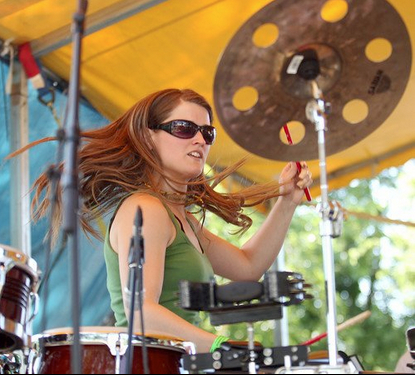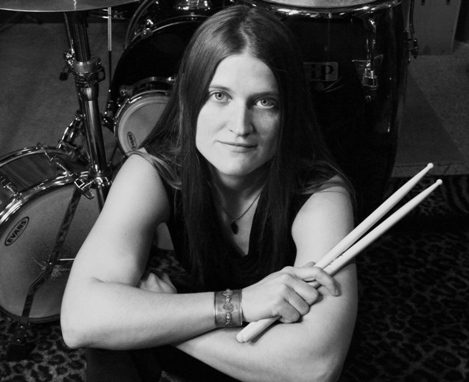 Chicago
Drummer and Percussionist Meg Thomas
Chicago
Drummer and Percussionist Meg Thomas
 Chicago
Drummer and Percussionist Meg Thomas
Chicago
Drummer and Percussionist Meg Thomas
 Drummer
and percussionist Meg Thomas, may not be a name that you are familiar with yet,
but keep your eyes on her and your ears tuned to this affable musician who now
makes her home in Chicago, because she is already well respected within the
music community and in 2010 she was named by
Drum Magazine as the runner-up for
“Rising Star Percussionist.”
Drummer
and percussionist Meg Thomas, may not be a name that you are familiar with yet,
but keep your eyes on her and your ears tuned to this affable musician who now
makes her home in Chicago, because she is already well respected within the
music community and in 2010 she was named by
Drum Magazine as the runner-up for
“Rising Star Percussionist.”
“That
was a total surprise to me. I was having a busy summer, percussion wise and a
buddy of mine sent me a text asking if I had seen the August issue of
Drum Magazine, and I said no, why? He
said the Drummies were announced and
you should take a look. I was like, I am at a gig right now and who is the
drummer of the year? I was trying to figure out what he was getting at. He said
no, you won one and you are runner up for one. I was like what, what? That’s not
true. Immediately I went to try and find the magazine and I couldn’t find it
anywhere of course. When I got home, I looked it up online and I thought that is
neat. That is me. I sent a text to my friend Vic Salazar who owns the big drum
shop in Chicago called Vic’s Drum Shop and I said, could this really be me?
Could this be another person? He said no that’s ridiculous, it’s you.
Drum Magazine contacted me and I got
a couple of free copies of the magazine. It was totally cool. I didn’t expect it
at all and it is all voted upon by the readers. It was a huge shock to me,” says
Meg Thomas.
Sometimes drummers become
the lost musicians at the back of the stage and percussionists in a band setting
are often viewed as “the people off to the side playing those instruments that
we don’t really understand,” but neither is true of Meg Thomas. Whether she is
playing congas, bongos or table, sitting on her throne behind the drum kit, with
her toms, cymbals, snares, timbales and bass drum or she has a shaker in her
hand Meg Thomas attracts a lot of attention both for her talent and the great
fervor with which she performs.
“I think when you are
going to see any kind of music, you want to see a show and you want to be
engaged with the musicians on stage. I want to put on a good show for the people
who are there to see us, because that is what it is all about, entertaining
people. Over the years, I have become comfortable with myself and being on
stage. It is about me being really connected to what I am doing and that just
comes out naturally,” she says as evidenced
in this video.
During her career Ms.
Thomas has performed in a wide variety of musical settings including, Latin
Jazz, Folk, R&B, Blues, Salsa, Soca, Calypso, Pop, Rock, Metal, World Music,
Reggae, Classical, Dance and New Age.
Responding to our question
as to how much freedom she enjoys when it comes to
interpreting music when it is written by
others, in one of the many bands and ensembles in which she performs, Meg Thomas
says, “It varies, depending on a couple of different factors, if you play
covers, you are locked into whatever that drummer did on the original recording,
if you want to do it, like that recording. (When playing) original music, with
certain projects, I found I have very minimal creative power and generally
speaking, I don’t stick with them, because I am obviously not expressing myself
within those (settings). With bands like The Wanton Looks (Rock),
I am writing all of my own drum parts. I try to be appropriate with the tunes,
but at the same time I try to be (creative). Because of my background with
multiple percussion instruments, I might think, oh this would be kind of cool if
I play a merengue groove, but I am taking it from a conga part and I am putting
it on a drum set and then I am really rocking it out. It’s not a straight
merengue by any means. It might not even be recognizable, but the idea is
founded from that. It becomes more syncopated, a lot more interesting and it is
not the typical part that you would find in a Rock tune.
As a percussionist, “When I get hired on with a group that I don’t normally play
with I have to figure out what I’m going to bring to play for that group.
Because they said percussion that means that it is not a drum set and I have a
whole lot of other drums to choose from a lot of combinations with those drums.
I try to get a vibe from whoever is leading the band and whom I am in contact
with. What are you going for? What is the sound that you are going for? I
generally will try to keep it within those bounds, nothing that is too weird and
crazy, but something that will still work with whatever style they are going for
musically. With the bands Od Tapo Imi (which
she left) and TROPIXPLOSION I slowly put a setup together over a couple of
years. At first, I was just playing congas and then after the timbalero left the
band, I decided to incorporate the timbales into my setup (which now included
bongos).
The setup is now to a point where I don't have to think about where my sound
sources are anymore. I know what I can get from the setup and I am able to play
timbale and bell / clave patterns with my left hand and the conga / bongo parts
with my right hand, as well as play each instrument exclusively.
There is Birdy which is kind of a Soul, Indie, Americana group and I have
another percussion setup in it. I wanted an organic sound and not a traditional
drum kit. I wanted to go with the whole idea of folk, but expanding that to folk
of different ethnicities or genres, so my setup with that is a djembe, a
darbuka, a conga, shaker, a tambourine and I play a bodhrán, an Irish frame
drum. For the Hannah Frank Quartet I have a hybrid drum set / percussion kind of
setup. There is a snare drum, a hi-hat, a conga and a gathering drum that I play
as a bass drum,” she says.
Being a drummer and a
percussionist also means your improvisational skills must be highly honed and we
are not talking about just while you are playing, we are referring to the
ability to adapt before the concert begins. For instance, when Meg Thomas was
preparing to play one particular gig there were restrictions placed on the type
of equipment she was allowed to bring and in fact eventually it was suggested to
her to leave her traditional drum kit at home. What to do?
“I said okay, we will make it like a recycled and
repurposed thing. I got there (the venue) and I saw that I had a ladder and
pipes and pans and buckets. I had about a half hour to set something up and make
something out of it, so I could perform to these tunes. It was a totally
different kind of a setup and a weird one at that to try to make it fit in to
these tunes, but it was interesting. That was kind of cool. I had all of these
different sound sources and areas that I could strike and I could come up with
all of these different types of pitches,” she says.

Growing up in the
Champaign / Urbana, Illinois area, a part of the state that also produced
drummer Brad Elvis (The Romantics, The Handcuffs) and Grammy nominated composer,
singer and pianist Chris Bennett, Meg Thomas remembers, “I came from a family of
music lovers, there wasn’t anybody playing music at home, but we had a piano. My
sister played flute and I took some piano lessons early on and that was (my
parents’) musical encouragement. I grew up listening to whatever my mom and dad
had on the radio. My sister played a larger part in that later on when I started
hitting my teens. I was listening to whatever she was listening to. She was
eight years older than I am, so she had some influence on my musical tastes as
well. She listened to the eighties Metal stuff and she loved some seventies
disco too. My dad listened to the fifties and the sixties Rock and Roll and with
my mom, it was whatever the popular music was on the radio stations. Her thing
was as long as it had a good beat and you could dance to it, she liked it. I
more or less got the full run of popular music.
I started playing piano,
but I really wanted to play drums, and my mom was, well we have a piano here at
home and it is a good foundation. I did that until they offered a band program
at my elementary school that started in the fifth grade. It was at that point
when I asked to play in the percussion section,” Meg Thomas recalls.
In high school Meg Thomas
continued being a part of the school band and then, “I went into college as a
business major and music minor, because I didn’t think it was practical to be a
music major. When I graduated, I was a music major and a Spanish minor.”
As for the musicians that
she was influenced by, early in her career, “I was really into Poncho Sanchez
and he is amazing. He always has a great group of musicians. I was lucky to see
him in Chicago several years back now. He is one of my favorite
congueros (conga players) and I love
his music. He is a pretty big influence that way. I got into Mongo Santamaria’s
music and of course Tito Puente’s music, not as much Tito’s stuff as some of the
others. Willie Bobo is another one that I got into and he had that
Spanish Grease album (1960). I really
got into that for a while and then I stepped away, before getting into it once
again.”
Meg Thomas believes percussion instruments are playing a more prominent role in
music today. “People are noticing that there are conga parts on Rock tunes and
there has been more of an influx of hand percussion in general. The cajon has
been a huge one. A lot of drum kit players can sit down with a cajon and make a
basic drum set out of it, without carrying a kit around. I certainly do see more
people who know what the instruments are that I am playing and they aren’t even
musicians.”
In September when Meg Thomas sat down with Riveting Riffs Magazine, she had just
returned from an east coast tour with The Wanton Looks and in October the band
will be doing a short southern tour.
This interview is protected by copyright © and may not be reproduced in print or on the internet or through any other means without the written permission of Riveting Riffs Magazine, All Rights Reserved